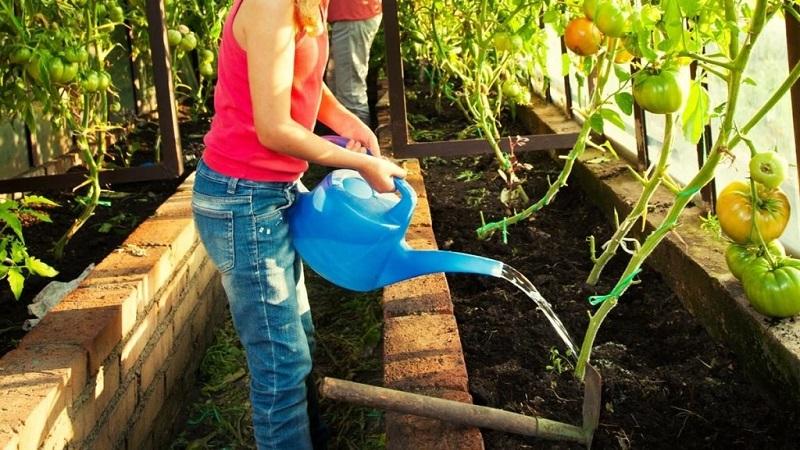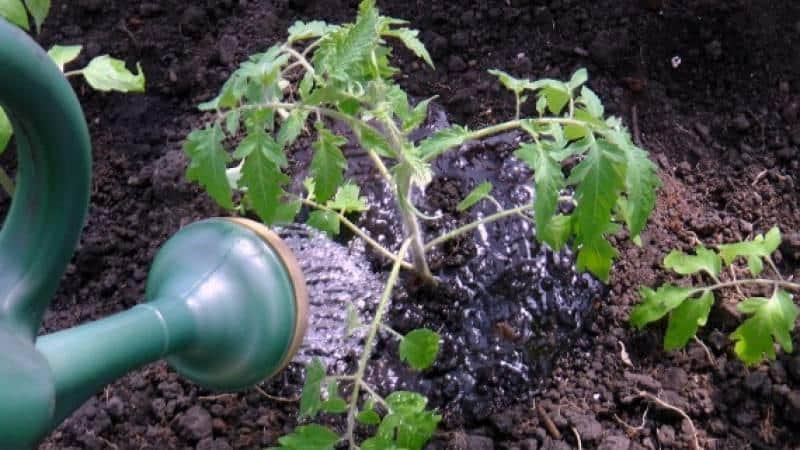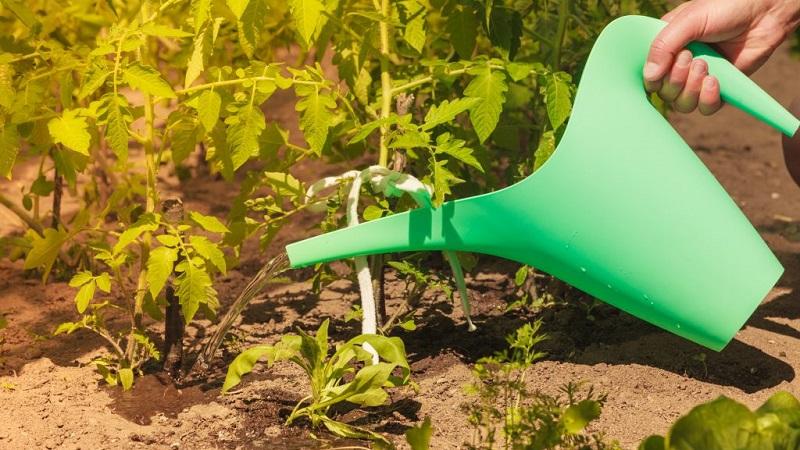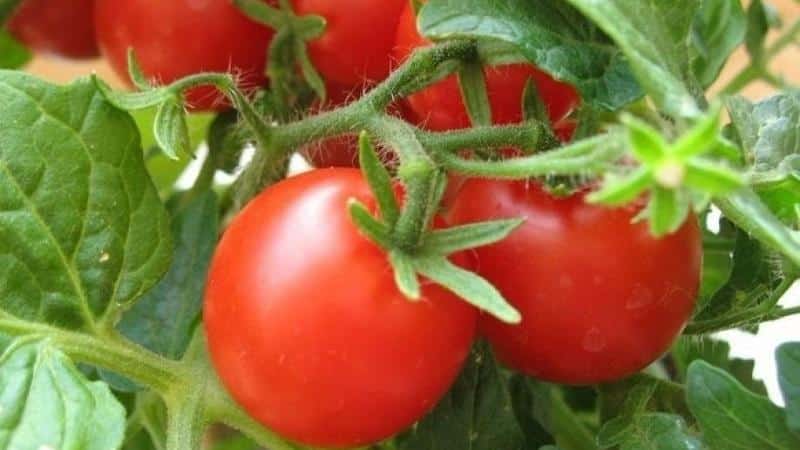How often to water tomatoes in hot weather to get a good harvest?
Of the varieties of tomatoes that grow in Russia, the smallest fruit has a diameter of less than two centimeters, and the heaviest weighs about one and a half kilograms. To get a harvest, tomato growers have to make a lot of effort: loosening, feeding, watering. And this needs to be done in any weather - both cold and hot.
Tomato lovers often wonder how to water tomatoes in hot weather? Let's look at the features of watering these plants. And we’ll find out how watering affects their health and productivity.
Why is watering important for tomatoes?
Tomatoes are considered a drought-resistant crop. This statement is true for plants planted in the ground and in the greenhouse using the seedless method (without picking). These tomatoes have a powerful root system. It is capable of collecting moisture itself, which is located at depth.
In Russia, the seedless method is used infrequently, since it does not allow early harvests. And tomatoes in our latitudes do not always have time to ripen before the onset of cold weather.

Most tomato growers grow tomatoes using seedling technology.. And with it, no matter how carefully the plants are handled when picking, the root system of the plant is disrupted. And in the future, an adult tomato that has been replanted will have roots located in the surface layer of soil. And it is drier compared to the earth at depth.
Since a tomato cannot independently extract water from the depths, it needs help. Namely, additional watering. Let's look at how to properly water tomatoes.
Features of watering for different stages of development
How to determine if it's time to water your tomatoes? Eat phases of plant development that differ in moisture requirements:
- From planting to flowering. The soil humidity in this phase is desirable at 70%.
- From flowering to fruiting. During this period, for full growth and ripening, tomatoes need increased soil moisture - 80-85%.
There are features for each stage. But few people on their site have instruments for measuring soil moisture. Therefore, tomato growers most often determine the need for watering visually. The tomatoes are carefully examined.
You need to water when the leaves of the plant begin to droop a little. In physical terms, this occurs when the pressure inside the plants begins to drop due to loss of moisture. As a result, the leaves weaken their tone and begin to sink to the ground.
There is an opinion that it is better to water tomatoes at certain intervals.. For example, once or twice a week. But you shouldn’t follow this rule, since tomatoes don’t have clear watering times.. It all depends on the condition of the plant, weather conditions, temperature and humidity of the earth. In addition, calendar dates also have an impact. In June, August and September, fruits need watering differently. On hot days, the need for water increases slightly.

How often to water tomato seedlings? All recommendations given above are also suitable for seedlings..
In the first two weeks after planting, experienced tomato growers recommend watering tomatoes moderately.. This is due to the fact that the plant must adapt and develop a root system in a new location.If you water the tomatoes excessively during this period, they will be “lazy” and their roots will be less embedded in the planting site. Most of the roots will remain in the top layers of soil.
When watering adult tomatoes, it is important to take into account the characteristics of each growth stage.. During tomato flowering, lack of water can lead to massive flower drop. During fruiting, overdrying of the soil affects the size of the fruit. They do not grow to the standards inherent in the plant variety. But you shouldn’t over-water the tomatoes during the fruiting period - the fruits on the branches may crack.
How much to water
How much water is needed for proper development and a good harvest? The amount of water is affected by the size of the bush, the method of cultivation, and the humidity of the soil.. On average, one adult tomato plant uses three to five liters of water. The numbers can vary both upward and downward.
Important! It is better to water evenly, avoiding drying out or waterlogging the soil.
Special attention is paid to water temperature. For beneficial watering of tomatoes, the water must be warm. Cold water is only permissible in the early stages of tomato growth. For example, for spring hardening.
During other periods, watering with cold water can even lead to the death of the plant. This is especially true during hot periods, when there is a large temperature difference between cold water, hot earth and heated plant.

Watering methods
It is better to water the tomatoes at the root. Tomatoes do not respond well to sprinkling. The three most common watering methods:
- Drip irrigation.
- In the holes.
- Along the furrows.
Attention! When watering along the furrows, you need to make sure that the roots at the water supply point under the tomato are not washed out or exposed.
Automatic and manual watering are equally effective. You can water the tomatoes either manually from a bucket, watering can or using a hose, or by installing an automated watering system. It all depends on the financial capabilities of the tomato grower.
What time of day to water
Some people prefer to water their tomatoes in the evening, after sunset.. This way, less moisture evaporates and more water goes to the roots. In addition, the risk of sunburn is eliminated if drops of water suddenly fall on the leaves or stems.
But it is more rational to water tomatoes in the morning (in the first half of the day). The benefit of morning watering is explained by the fact that the plants have time to ventilate before evening. Excess moisture disappears during the day. And there are no prerequisites for the development of fungal diseases and rot (late blight, brown spot).
Features of watering in hot weather
During extreme heat It is important that drops of water do not fall on the plant when watering. This will help avoid sunburn.
It is better to mulch the soil (cover with mulching material, for example, sawdust, leaves, pine needles, hay). This will save the earth from drying out under the hot rays.
Attention! A layer of mulch will be more effective if its thickness reaches five centimeters.
Water consumption in hot weather should be increased, because some of the moisture will evaporate and will not reach the plant. The average recommended amount of water per bush during the fruiting period is five to six liters.

Conclusion
Growing tomatoes is a troublesome business. Everything needs to be done on time - planting the seedlings, planting them in a greenhouse or open ground, and applying fertilizing. Regular watering is also important.
When watering tomatoes, adhere to the following rules: use warm water, water in the morning. It is important to do this regularly and in moderation. After all, excess moisture and overdrying are equally harmful to plants.